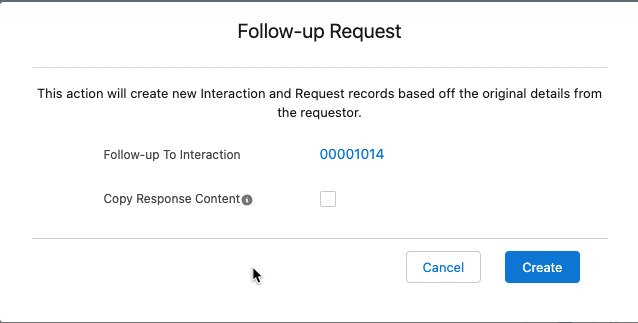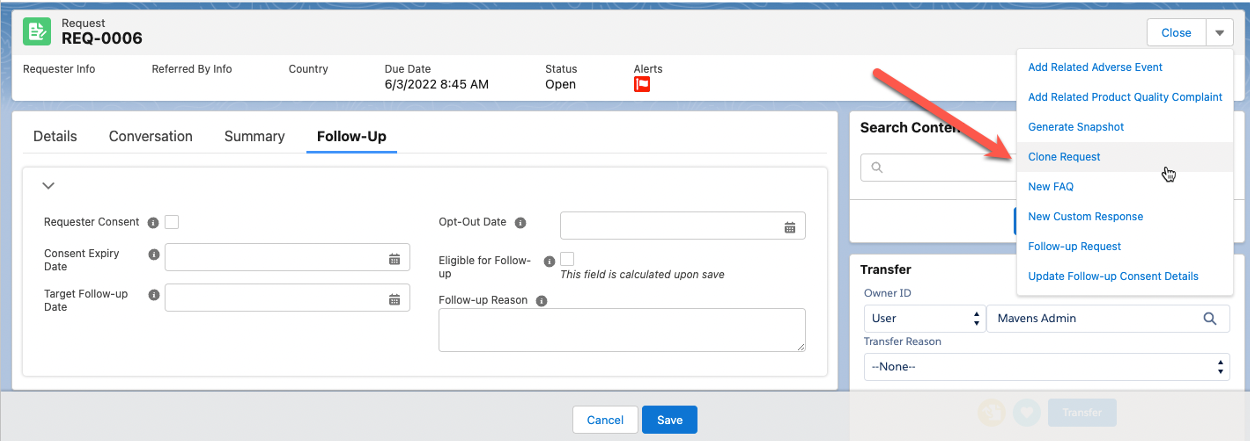Requests
A Request is a child record of an Interaction. Each Request stores information about the account's inquiry and any responses that have been provided. There can be multiple Requests in a single Interaction. For example, if an HCP asks multiple questions in a single email or conversation, each question will have its own Request within a single Interaction.

Request view
Besides the standard fields, the Request page layout also has embedded components in it. These components include:
Enhanced Record Edit
Requests can be edited as needed, with any changes automatically saved using the Enhanced Record Edit component. Visit the Enhanced Record Edit topic for more information.
Product Lookup
The Product Lookup Lightning component enables users to search the product database and select a product value for MED_Product__c.
Each product result contains the name of the product and a subtitle. The subtitle is comprised of product metadata separated by the “•” character.
Visit Product Lookup for more information.
Request Content Search
The MIC - Request Content Search component adds a search bar and button to the default Request Record page. The search bar and button launch a search modal and immediately execute the search. From the modal, you can filter results, refine your search, attach documents to the Request record, and preview a document search result in a modal with the document viewer.
Visit Request Content Search for more information and configuration instructions.
Interaction Follow-ups
You can create a Follow-up Interaction and associated Request to communicate content updates to requesters who have given consent to receive them using one of the methods below.
To record a requester's consent using the Edit icon:
In an open Request, click the Follow-Up tab.
Click the Edit icon in the Requester Consent field.
Check the box in the Requester Consent field to indicate their consent.
Complete the following fields, if applicable:
Consent Expiry Date
Target Follow-up Date
Opt-Out Date
Eligible for Follow-up
Follow-up Reason
Click Save.
To record a requester's consent using the Update Follow-up Consent Details quick action button:
In an open Request, click the dropdown arrow in the top right of the Request section.
Select Update Follow-up Consent Details.

Use the Update Follow-up Consent Details modal to record the relevant requester consent details.
Click Save.
Note
You can use the Update Follow-up Consent Details quick action button if the request is open or closed. However, once the request is closed, you can only use the quick action button to update consent information.
To record a requester's consent on fulfillment, visit the Configure follow-up opt in/opt out emails section. You can use the fulfillment email templates that are provided out-of-the-box and configure them so that requesters can either opt in or out of receiving updates.
Adding a Follow-up Interaction to a Request
To add a Follow-up Interaction to a Request:
In an open Request, click the dropdown menu in the top right of the Request's highlight panel.
Select Follow-up Request. The Follow-up Request modal appears.
To copy content from the content repository, click the Copy Response Content checkbox. Otherwise, leave it unchecked.

Click Create. You are automatically brought to the new Request page within the new Interaction.
The new Interaction is created with the following values pre-populated:
Channel = Follow-up
Follow-up To = Original Interaction from which the Interaction was created
Status = Open
The new Request is created with the following values pre-populated:
Interaction number
Owner
The new Request has the following values removed:
Date Opened
Date Closed
Due Date
Note
A request created by a Follow-up cannot be created from a request that is also a Follow-up. For requests that were made from a Follow-up, the contents of the Follow-up tab will not appear since the consent was recorded in the original request.
Cloning a Request
Previously created Requests can be cloned and associated with new Interactions. This helps facilitate an easier workflow by reusing commonly used question and answer content.
To clone a Request:
From a Request, click the dropdown caret in the top right and select Clone Request.

On the Clone Request modal, either keep the pre-populated Interaction in the Parent Interaction field or search for and select a different one.
Check the checkbox next to Copy Response Content to copy the content into the cloned request.
Click Clone.
Once cloned, the system will automatically:
Put the cloned request in "Open" status.
Clear any related Inbound Form lookups (if applicable).
Automatically update the Cloned From field with the record from which the new record was cloned.
Configuring the Follow up tab on a Request record
You can enable your users to capture consent details as part of a broader workflow. Using the steps below, you can allow them to capture consent from a requester to follow up with more information at a later date.
To configure the Follow-up tab on a Request record:
From Setup, click the Object Manager tab.
Search for and select the Interaction (
Case) object.Click Fields & Relationships.
Select the Channel field and add 'Follow-up' as a picklist value.
From Setup, click the Object Manager tab.
Search for and select the Request (
MED__Request__c) custom object.Click Lightning Record Pages on the left side navigation panel.
Click Request.
Click Edit. The Lightning App Builder appears for the Request page.
Select the Follow-up tab.
Click the Fields tab on the navigation panel on the left side of the page.
Under the Fields Component section, click and drag Field Section, and drop it onto the Follow-up section.
Under the Fields section on the navigation panel on the left side of the page, click, drag, and drop the following fields:
Requester Consent
Consent Expiry Date
Target Follow-up Date
Opt-Out Date
Eligible for Follow-up
Follow-up Reason
Click the Requester Consent section you just created. On the right side of the page, enter "Requester Consent" in the Label field.
Click Save.
Configuring the Follow-up Action on a Request
You can enable your users to create a Follow-up Interaction and associated Request as part of a broader workflow. This workflow would allow them to capture consent from a Requester to follow-up with more information at a later date, or simply associate a new Request with a previously relevant interaction using the methods below.
To configure the follow-up action on a request:
From the Request page in the Lightning App Builder, click the highlights panel.
On the right side of the page, under Actions, click Add Action. A search modal appears.
Search for and select Follow-up Request and click Done. It now appears under the list of actions.
Click the new Follow-up Request action and drag it to the appropriate position.
Click Save.
Custom Objects
Request - The Request object stores information about medical inquiries and the provided responses.